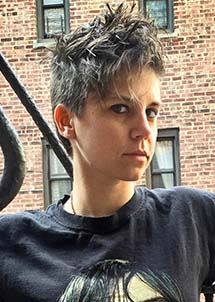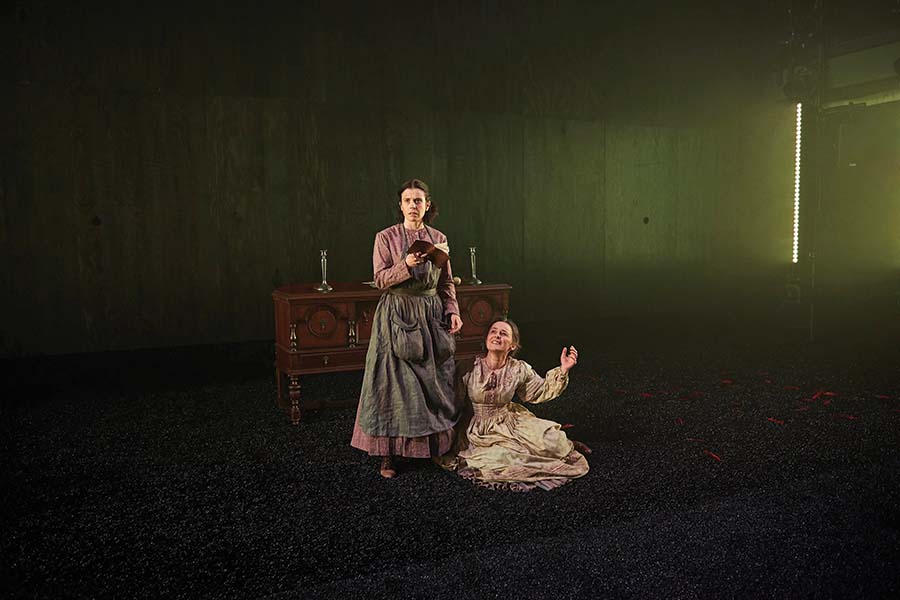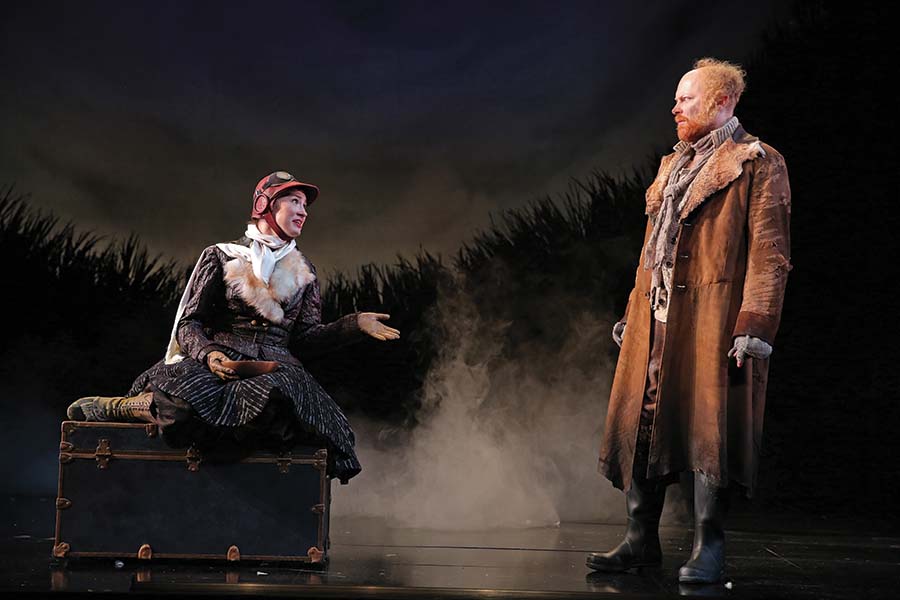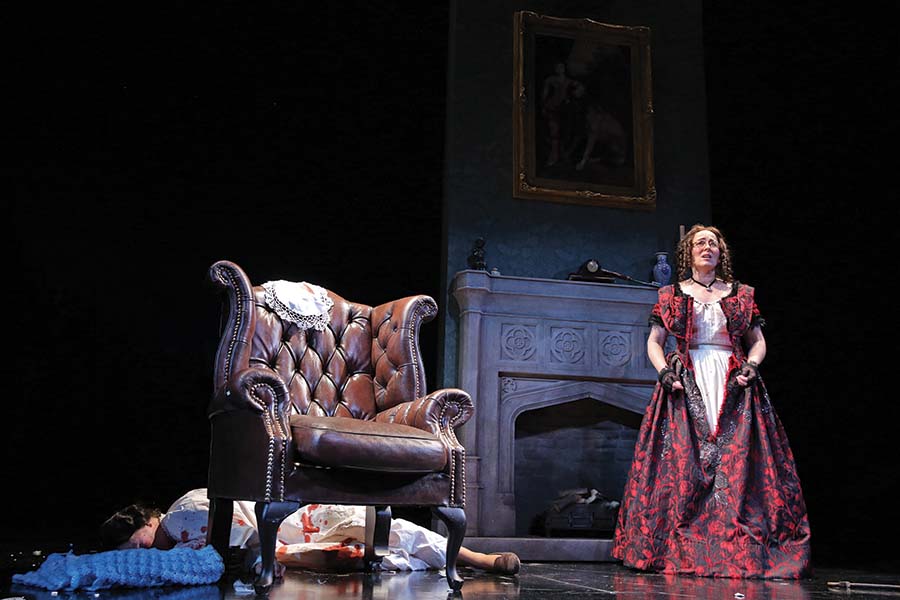
Playwrights Jen Silverman and David Adjmi met for the first time when Adjmi taught a class at the Iowa Writers’ Workshop, where Silverman was in graduate school. Silverman remembers Adjmi instructing her on how to make a life in the theatre. Here they discuss her play The Moors, the complete playscript of which can be found in the July/August 2017 print issue of American Theatre.
DAVID ADJMI: I remember reading an early play of yours, which was an adaptation of Baba Yaga. That play, as in The Moors—it’s not all of your plays—as crashing together genres and myth and contemporary stuff, and you created your own idiom inside it. What’s the provenance of this impulse to crash together genres and time periods? Where does it come from in you?
JEN SILVERMAN: I grew up moving around the world, as you know. My parents are scientists, and my dad worked internationally for a time, so we moved around a lot—different parts of the U.S., Europe, and Asia.
So you were displaced everywhere.
Yeah, always, although it never felt like a bad thing to me. But because of that, I grew up drawing from many different traditions or stories. On the surface you could go, “Oh, this is a story from Japan” or “This is a myth from Germany,” but ultimately the heart of those stories is all fed by the same thing.
It’s that Joseph Campbell thing.
Yeah! Human storytelling, as varied as it is, all has the same beating heart: loneliness, fear, desire, the attempt to connect with something higher, the attempt to reconcile with our failures—it’s all the same story. So initially I didn’t think of it as smashing together many different sources—it felt very much like the same multi-textured source. But eventually I started investing in the dictates of genre, of time period, of audience expectation around a certain set of tropes. And since then, part of my desire has been to use a genre as a container, and then within the safety of that container make it unsafe, blow it up, make it present-tense and dangerous.
When you’re dealing with these tropes of Victorian culture in The Moors, and then you introduce these violent things inside of that thing, it does feel more shocking.
Right! And something that felt vital to me, when I was writing The Moors, was disrupting a set of conventions that have to do with visibility, the way that women are seen—in our current cultural moment, not in some invented Victorian moment. I wanted to use the vehicle of genre to invite us into a conversation about right now. I have never thought of The Moors as a period piece, and in the playwright’s note, I ask actors not to put on British period-piece accents. Just do the play in whatever your native accent is—American or Australian or whatever. It’s a play about this exact moment in time.
There’s so much going on with genre here too, because clearly we have the Brontës, and then I was thinking Daphne du Maurier and Flowers in the Attick—his pulp-Victorian-mashup-gothic-satire. There’s sort of an Ionesco thing too. Was any of this conscious on your part, or am I just making all this up?
It is 100 percent accurate, and very little of it was conscious. I mean, I love du Maurier, I love so many of the references you just made. But when I wrote the first draft, none of that was on my mind. I was doing the FreeWrite residency at Williamstown [Theatre Festival in the Berkshires], where you go up there for a week and you work on whatever you want. I had been going through a pretty hard life moment, and I kind of stumbled off an Amtrak, moved into a dorm room, and wrote the play.
You did it in a week?
The first draft—obviously it’s changed since then. Writing it didn’t feel different from writing a realistic play; I wasn’t consciously thinking, “Oh, let’s explore genre.” I’d spent months reading all these letters from Charlotte Brontë, so in a way that was just the theatrical language I was steeped in.

Did you think, “I want to write a play about this”? Was it research, or did you just want to read Brontë?
I had no thought of writing a play, I just got sucked in. The letters are so seductive! The voice in them is so strong, and so is the world that she’s painting of—these wind-blown, desolate moors. I was so fascinated by that, and by the idea of this woman who is living two lives: She’s living the life of a spinster in an isolated house and then she also has this bold, literary voice that is traveling out and away, to places she herself can’t reach.
When I started writing, it wasn’t in any way an adaptation of the Brontës. It simply felt like I had been in conversation with this voice for a few months, and here I was in a very difficult and private moment at Williamstown, continuing a conversation—about intimacy, visibility, isolation, desire. And of course, after the fact, when the rewriting and sculpting starts, then you’re like: Oh, I’m having a particular interaction with genre—that’s when craft comes into play.
Reading this play I thought about horror films like The Fog or The Blob—the moors are this pervading force threatening to consume and destroy the people. Do the moors have a specific valence for you?
Part of what felt crucial to me in rendering the play was leaving space for collaborators. There’s a lot of mystery for me around the world of the moors, and much of what I tried not to do on the page was solve the mystery. In terms of both the moors and the house, the description is deliberately spare. I always want to leave space for designers and actors. In both the Yale production and the Playwrights Realm production, when talking with the two different design teams, the thing that felt important to me was that the moors had to feel both beautiful and dangerous. And from the convergence of beauty and danger, we get the mystery.

They’re also a place where things are both obscured and made visible. So much of this play is about people looking for ways to be known or seen. How much is it a personal play for you?
I’ve had a couple of interviews recently where people are like, “So it’s clear that you don’t write personal plays, and your plays are these weird genre/structure things. Do you think you’ll ever write a play that’s about you?” And I find that hilarious—not because I don’t get it, but because I do. I understand that it’s easy to see some of my plays as these strange, structurally subversive things, but to me, those are sometimes the most personal of all.
Whether it’s The Moors or Collective Rage or Wink, these plays hinge on characters contending with desire and loneliness and fear and transformation. These characters are reaching moments in their lives where they’re saying: I must change, how do I do it? Can I do it? And so for that reason alone, it’s hard for me to think of these as style pieces or genre pieces, because they’re stories about human hope and failure and struggle and change, and of course my understanding of those things is personal and lived.
As much as The Moors operates in a non-hyper-realistic format, it is a story about intimacy and the terrible struggle to be seen, to be known, to know yourself. Many of the characters make inexorable mistakes because they are so close to finally breaking out of their loneliness, they take one final step and go over the edge of the cliff. Of course the play makes use of hyper-theatricality, but I guess I don’t understand the separation between theatricality and emotional authenticity. I go to the theatre to be shown truths about myself in ways that are surprising, but that are nonetheless personal and true.
I also think The Moors feels very, very personal and in some ways deeply anguished and sad. It’s such a funny play, but there’s a very anguished core that’s so moving to me.
I keep thinking of your play Marie Antoinette, because for me that is such a personal, visceral play that makes use of genre and of history, but I would never call it a “genre piece” or a “period piece.” When I read it and then when I saw it—both the productions at Yale and then at Soho Rep—it really moved me. Genre was a skeleton in some ways; “genre” was the bones holding it up, but there was an anguished beating heart inside of it.
Yeah, I do think I need a container—some way to talk about things that are too intimate or too private. Playwrights are like this, I think. We want to hide ourselves, and we want to expose ourselves at the same time—here are these dueling impulses. So I think what you’re doing with this play, and what I do sometimes, is making this holographic interface, where you’re there but you’re not there. And again, it’s like the moors: hiding things but then revealing things at the same time.


